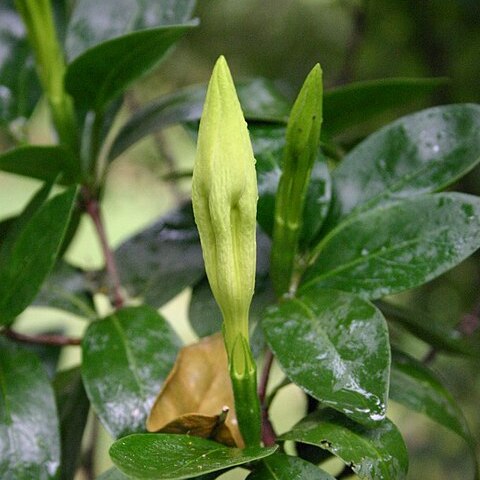Evergreen tree, 3-7(-14) m high. Leaves opposite or occasionally ternate, elliptic, dark, shiny green; domatia distinct on upper surface, hairy in nerve axils below; petioles short, widened. Calyx with cylindrical tube; lobes 5, up to 8 mm long, erect. Corolla 5-lobed, showy, widely campanulate, white or yellow with maroon streaks or speckles. Stamens 5, in corolla mouth, subexserted; anthers sessile, linear. Flowering time Dec.-Feb. Fruit globose, faintly grooved lengthwise; hard at first, softening at maturity, crowned with small remains of persistent calyx.
A medium sized tree. It is evergreen. The trunk is slender and straight. It can be 10 m high. The branches go out horizontal and droop down at the ends. The leaves are opposite, with an odd third leaf. The leaves are crowded towards the ends of branches. The crown is narrow. The flowers are at the ends of branches. They occur singly and are white with red streaks inside. The fruit is round and 7 cm across. They are green.
Leaf blades 3.2–12 × 1.5–5.5 cm, elliptic to broadly elliptic, obtuse to acute at apex, acute at base, subcoriaceous to coriaceous, moderately shiny above, glabrous or sometimes pubescent beneath when young; domatia present as hair-lined pits, clearly visible as blisters on upper surface; petioles 1–3(5) mm long; stipules 3–5 mm long, triangular usually with a decurrent acumen, eventually caducous.
Corolla white or cream, with maroon spots in the throat, sometimes these in lines behind anthers not extending to base of lobes, glabrous or glabrescent outside; tube 3.5–5.5 cm long, the widened portion 2.2–3.5 cm long and 1.8–3.4 cm wide at the top; lobes 2.7–3.5 × 1.2–1.6 cm, ovate, long acuminate, usually ciliate, overlapping to the right in bud.
Tree, up to 10 m high. Calyx limb never splitting, lobes linear, (5-)10-22 mm long, always separated by sinuses. Corolla tube campanulate to funnel-shaped above, lower cylindrical portion a third to half of total length, lobes 27-35 mm long. Fruit spherical, ribbed. Flowers white to cream with purple spots in throat.
Calyx glabrous or occasionally finely pubescent; tube 0.6–1 cm long; limb-tube (0.6)1.2–1.4 cm long, tubular, never splitting; lobes linear (0.5)1.1–2.2 cm long, the bases well separated by sinuses, ciliate.
Shrub or small tree 2.4–16 m tall; young branches glabrous or less often finely pubescent, older branches with bark flaking off to reveal a rusty-coloured underlayer.
Fruit 7–8.5 cm in diameter, spherical with 5(or 10) shallow, well spaced ribs; calyx limb deciduous leaving a pale pentangular scar.
Tree to 14(-20) m. Leaves opposite, elliptic. Flowers cup-shaped, sessile, solitary, terminal, white to cream-coloured.
Flowers solitary; peduncle very abbreviated; pedicels up to 2 mm long; bracteoles resembling reduced stipules.
Pollen presenter 2–2.5 × 0.15–0.3 cm, exserted.
Anthers c. 2 cm long, ± one third exserted.
Seeds c. 7 × 7 × 2–2.5 mm.
Style 2.5–5.5 mm long.


